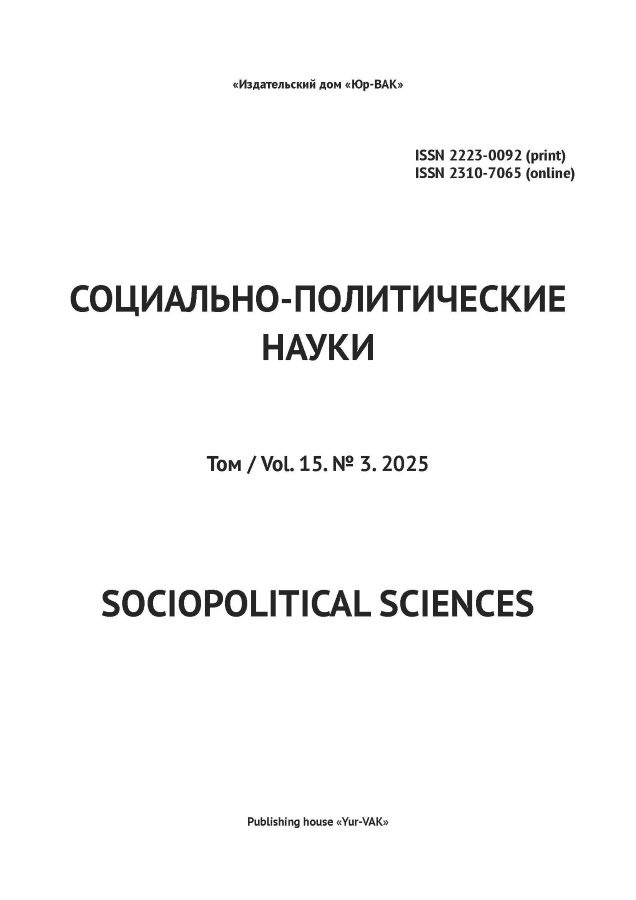Legal Experience of Labeling “Invisible” Religious Stigmatizations (Based on the Materials of the PSRI)
- 作者: Arinin E.I.1, Volkova V.E.1
-
隶属关系:
- Alexander and Nikolay Stoletov Vladimir State University
- 期: 卷 15, 编号 3 (2025)
- 页面: 229-235
- 栏目: Philosophy of religion and religious studies
- URL: https://journals.eco-vector.com/2223-0092/article/view/687924
- DOI: https://doi.org/10.33693/2223-0092-2025-15-3-229-235
- EDN: https://elibrary.ru/SJPKSW
- ID: 687924
如何引用文章
详细
This work is a religious studies analysis of a number of texts in the first volume of the first collection of the “Complete Collection of Laws of the Russian Empire” (hereinafter – the PSRI), focused on the phenomenon of “invisibility” of religious communities, which is viewed through the prism of regulatory regulations and stigmatization. The purpose of the study is to study several key concepts in the field of religious studies, namely the concept of “invisibility” introduced by Niklas Luhmann, with an emphasis on its two main aspects: 1) the impossibility of simultaneously observing phenomena and conducting self-observation, and 2) monitoring sacred reality. An analysis of a number of documents from the 17th century demonstrates how “religious stigmatization” was formed, which manifested itself in legal regulations regarding punishments for “deviations from the norm”. Thus, the PSRI acted not only as a legal body, but also as a tool visualizing religious minorities that were previously “invisible” to the authorities.
全文:
作者简介
Evgeny Arinin
Alexander and Nikolay Stoletov Vladimir State University
编辑信件的主要联系方式.
Email: eiarinin@mail.ru
SPIN 代码: 5251-4026
Scopus 作者 ID: 37060239800
Dr. Sci. (Philos.), Professor; Head of the Department of Philosophy and Religious Studies
俄罗斯联邦, VladimirValeria Volkova
Alexander and Nikolay Stoletov Vladimir State University
Email: volkova170204@outlook.com
SPIN 代码: 8635-4843
Student at the Department of Philosophy and Religious Studies
俄罗斯联邦, Vladimir参考
- Arinin E.I., Volkova V.E. The phenomenon of the mask between invisibility and visualization of the imaginary “invisible” (religious aspects). Candle. 2023. No. 40. Pp. 14–22. (In Rus.)
- Arinin E.I., Volkova V.E. The mask in the age of digitalization: Between the visualization of the sacred and the invisibility of the true. Humanitarian Bulletin of the Tolstoy State Pedagogical University. 2024. Vol. 2. No. 3. Pp. 108–117. (In Rus.)
- Avdeev A.G. New epigraphic sources about the pestilence in 1654 in Moscow Russia. Bulletin of the PSTU. The History of the Russian Orthodox Church. 2021. No. 1 (40). Pp. 121–132. (In Rus.)
- Brockhaus F.A., Efron I.A. Artaxerxes' action. In: Encyclopedic dictionary of Brockhaus and Efron. St. Petersburg: Semenovskaya Typolithography (I.A. Efron), 1890. Vol. II (3). P. 180.
- Dahl V.I. Explanatory dictionary of the living Great Russian language. In 4 vols. I.A. Baudouin de Courtenay (ed.). 3rd ed., ed. and significantly additional. St. Petersburg. Moscow: M.O. Wolf Publishing House. Vol. 4. 1909. 1619 p.
- Zhivov V.M. Two generations of the Russian Middle Ages and two new metamorphoses of the access mode. URL: https://web.archive.org/web/20170303123013/http://magazines.russ.ru/oz/2004/5 (data of accesses: 17.03.2025).
- Klyuchevsky V.O. Course of Russian history. Vol. 3. Part 3. Moscow: Mysl, 1988. 414 p.
- Luhmann N. Differentiation. B. Skuratov (transl. from German). Moscow: Logos, 2006. 320 p.
- Nestor the Chronicler. The tale of bygone years. D.S. Likhachev, O.V. Tvorogov (transl.). St. Petersburg: Vita Nova, 2012. 512 p.
- The complete collection of laws of the Russian Empire. Meeting 1st. From 1649 to December 12, 1825. Vol. 1. St. Petersburg, 1830. 1029 p.
- Lemert E.M. Human deviance, social problems and social control. Englewood Cliffs, 1967. 292 p.
补充文件








